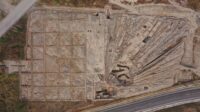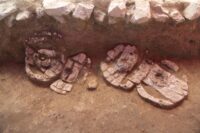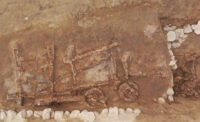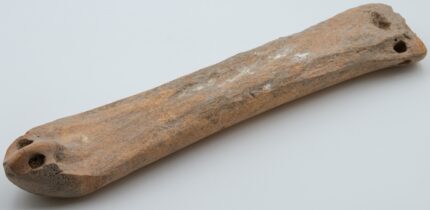Two pairs of animal bone skates made 3,500 years ago have been discovered at the Gaotai Ruins in northwest China’s Xinjiang region. Made of ox and horse bones, they are the first bone skates found in China.
Archaeologist Ruan Qiurong, of the Xinjiang Institute of Cultural Relics and Archeology, told reporters that the newly-found skates are almost exactly the same as ice skates from prehistoric Europe, which can be interpreted as new evidence of a theorized exchange of information between the ancient west and east in the Bronze Age. They are also rare physical material for studying the origins of ice skating in China, he said.
Each blade is perforated twice at the front and back. Leather straps would have been threaded through the holes and tied to the wearer’s shod feet. The front of the skates come to more of a point while the back widens to a blunt end. They are flat compared to modern ice skate blades, but the carving and curvature of the bone still formed enough of a cutting edge to allow the wearer to glide in the melt created by contact with the ice surface.
 The Goaotai Ruins are part of the Jirentai Goukou site, a Bronze Age settlement and high platform tomb of the Andronovo culture of cattle-herders. The remains of the settlement are about half a mile from the tomb area where the skates were found. Between 2019 and 2022, archaeologists excavated the high platform tomb, uncovering a stone-built tomb complex that is the largest and best-preserved Bronze Age tomb ever discovered on the Eurasian steppe. The settlement and tomb date to between the 16th and the 15th century B.C.
The Goaotai Ruins are part of the Jirentai Goukou site, a Bronze Age settlement and high platform tomb of the Andronovo culture of cattle-herders. The remains of the settlement are about half a mile from the tomb area where the skates were found. Between 2019 and 2022, archaeologists excavated the high platform tomb, uncovering a stone-built tomb complex that is the largest and best-preserved Bronze Age tomb ever discovered on the Eurasian steppe. The settlement and tomb date to between the 16th and the 15th century B.C.
The high platform mound has a square base covering an area of 3.7 acres that is enclosed by a stone wall. On the ground outside the wall are 17 lines paved with laterite (a rock type that is high iron oxide) in a radial pattern that looks like a sunburst when seen overhead. This may be an indication that the culture practiced a form of sun-worship.
 The bone skates are not the only archaeological firsts made at the site. Last year’s excavation unearthed more than 40 pieces of wooden vehicles buried in two groups. There are 11 solid wooden wheels surviving, plus component parts of a cart including shafts, axles and carriages. Archaeologists believe they were used in the construction of the platform mound and then deliberately dismantled for burial. These are the earliest wooden wheels discovered in China.
The bone skates are not the only archaeological firsts made at the site. Last year’s excavation unearthed more than 40 pieces of wooden vehicles buried in two groups. There are 11 solid wooden wheels surviving, plus component parts of a cart including shafts, axles and carriages. Archaeologists believe they were used in the construction of the platform mound and then deliberately dismantled for burial. These are the earliest wooden wheels discovered in China.
 Excavation of the tomb unearthed a wealth of other artifacts, more than 2,000 objects and remains in total. Most of them are pottery and stone tools. The pottery is handmade and comes in a profusion of different shapes and sizes — cylindrical pots, round pots, pots with folded shoulders, pots with high necks, clay cups. A smaller proportion of bronze, bone and iron tools were also discovered, and numerous bones of domestic animals (cattle, sheep, horses). Archaeologists believe the prevalence of animal remains is evidence the tomb belonged to an elite herding family of the Andronovo culture.
Excavation of the tomb unearthed a wealth of other artifacts, more than 2,000 objects and remains in total. Most of them are pottery and stone tools. The pottery is handmade and comes in a profusion of different shapes and sizes — cylindrical pots, round pots, pots with folded shoulders, pots with high necks, clay cups. A smaller proportion of bronze, bone and iron tools were also discovered, and numerous bones of domestic animals (cattle, sheep, horses). Archaeologists believe the prevalence of animal remains is evidence the tomb belonged to an elite herding family of the Andronovo culture.
